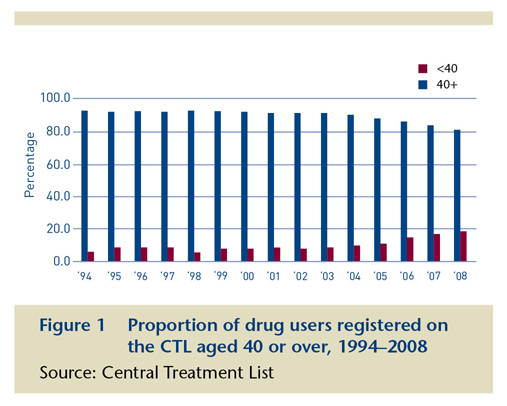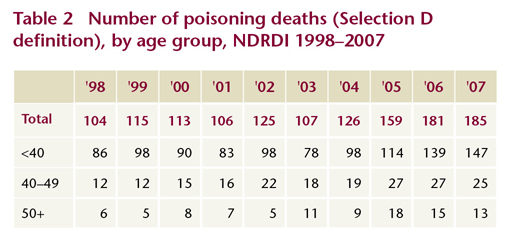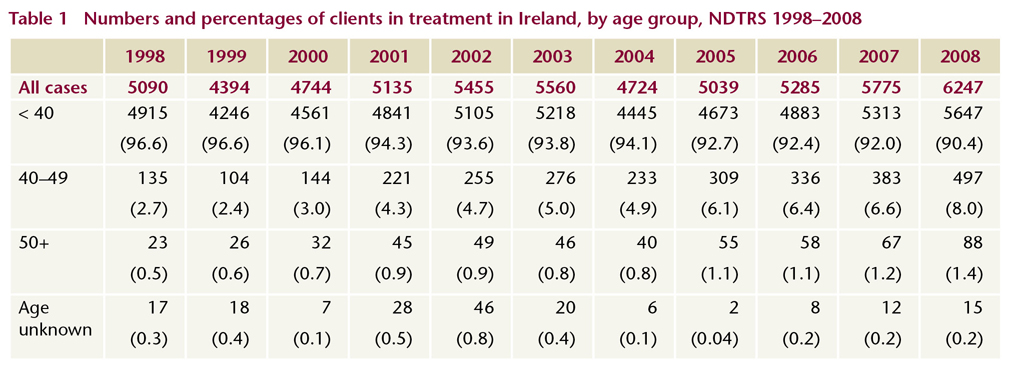Lyons, Suzi
(2011)
Older drug users in Ireland.
Drugnet Ireland,
Issue 36, Winter 2010,
pp. 6-7.
One of the key topics focused on by the European Monitoring Centre for Drugs and Drug Addiction (EMCDDA) in 2010 was older drug users (defined by the EMCDDA as those aged 40 years or over).1 This article summarises the information on this topic provided by the EMCDDA Irish national focal point, which is based in the Health Research Board.
As the proportion of those aged over 40 in the general population increases, and improvements in drug treatment lead to better survival rates among drug users, the proportion of drug users over the age of 40 is also increasing. This trend is likely to continue and may present challenges for the health services, including the drug treatment service, in the near future. This issue has not been examined previously in Ireland. Data from the National Drug Treatment Reporting System (NDTRS), the Central Treatment List (CTL) and the National Drug-Related Deaths Index (NDRDI) were analysed to provide an overview of the total numbers and also to give a description of those drug users aged 40 or over in treatment, and those in this age group who have died due to drugs.
Treatment data
Between 1998 and 2008, the proportion of cases aged 40 or over reported to the NDTRS increased almost every year, rising from 3% of the total in 1998 to 9% in 2008. The increase was most evident in the 40–49-year age group, where the proportion of cases rose from 3% in 1998 to 8% in 2008 (Table 1).
The majority of those in the 40–49-year age group reported heroin as their main problem drug, with the proportion increasing from 53% in 1998 to 70% in 2006, and falling slightly to 66% in 2008.
The majority of those in the 50–59-year age group also reported heroin as their main problem drug, although the numbers were much smaller. Among this group, the proportion reporting heroin as their main problem drug increased over the 11-year period under review, from 27% in 1999 to 55%% in 2007, again showing a decrease in 2008, to 47%.
Other opiates and benzodiazepines were reported as the main problem drug for the majority of drug users aged 60 years or over.
Only a small proportion of older drug users reported cocaine as their main problem drug. The proportion fluctuated over the 11-year period, rising from 3% in 1998 and peaking at 7% in 2007, before dropping slightly in 2008 to 6.5%. Very few drug users aged over 50 years reported cocaine as their main problem drug.
Central Treatment List
Data provided by the Central Treatment List show that the number of individuals in methadone treatment has increased since 1994 (Figure 1). The proportion of drug users aged 40 or over registered on the CTL has more than quadrupled, from 4% in 1994 to 19% in 2008 (Figure 1).

Drug-related deaths
Analysis of NDRDI data showed that, of the total deaths owing to poisoning (as per EMCDDA Selection D definition2) between 1998 and 2007, 290 (22%) were of individuals aged 40 or over. The number of deaths in this group increased from 18 in 1998 to 45 in 2005, and decreased slightly to 38 in 2007 (Table 2). The majority (67%) of this group were in the 40–49-year age group. The majority (63%, 184) of older drug-related deaths were male.

Overall, opiates were the drugs most frequently implicated in poisoning deaths among older drug users, many of which were polysubstance poisonings. Cocaine was only occasionally implicated in deaths owing to poisoning in this group. For those aged 50 or over, the opiates implicated were rarely heroin or methadone.
Overall, national data point to an increase in the number of problem drug users aged 40 years or over. This indicates an aging drug-user population, owing either to improved survival rates or to longer drug-using careers. The number of older drug users is likely to continue to increase over the coming years. Heroin continues to be the main problem drug for most users, irrespective of age. At policy level in Ireland to date, older drug users have not been identified as a vulnerable or high-risk group. This may need to be addressed if the number of older drug users continues to rise.


